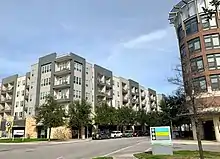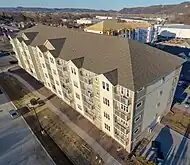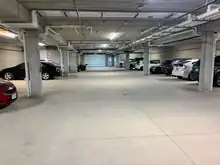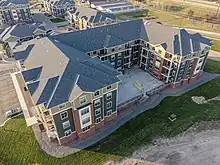5-over-1
5-over-1 or over-1s also known as a one-plus-five, or a podium building,[1] is a type of multi-family residential building commonly found in urban areas of North America.[2][3] The mid-rise buildings are normally constructed with four or five wood-frame stories above a concrete podium (usually for retail or resident amenity space). The name derives from the maximum permissible five floors of combustible construction (Type III or Type V) over a fire-resistive Type I podium of one floor for "5-over-1" or two floors for "5-over-2", as defined in the United States-based International Building Code (IBC) Section 510.2.[1][4] Some sources instead attribute the name to the wood framing of the upper construction; the International Building Code uses "Type V" to refer to non-fireproof structures, including those framed with dimensional lumber.[5][6]




The style of buildings originated with the work of architect Tim Smith in Los Angeles, who took advantage of a change in construction code allowing the use of fire-retardant treated wood (FRTW) to construct buildings up to five stories.[7][5] From this he saw that what became the "Five-Over-One" model would bring the construction costs down substantially, making a 100-unit affordable housing project financially viable.[5]
The style took root in New York and other dense cities in the American Northeast following the revisions in the 2000 IBC edition,[5] and it exploded in popularity in the 2010s, following a 2009 revision to IBC, which allowed up to five stories of wood-framed construction.[8]
Description
The first recorded example of 5-over-1 construction is an affordable housing apartment building in Los Angeles built in 1996.[7] The wood-framed 5-over-1 style is popular due to its high density and relatively lower construction costs compared to steel and concrete.[9] 5-over-1 buildings often feature secure-access interior hallways with residential units on both sides, which favors a U, E, C, or right-angle building shape.[7] The exteriors of 5-over-1 buildings often contain flat windows, rainscreen cladding, and Hardie board cement fiber panels.[2]
These buildings are also sometimes called a Wrap or Texas Doughnut, which describes a multifamily building which is wrapped around a parking garage in the center.[10][11] This style is common in areas with higher parking mandates.[7]


Criticism
The 5-over-1 style of buildings are often criticized for their high fire risk when under construction,[12] as well as their architectural blandness.[2][7][13] Some cities and jurisdictions have considered additional regulations for multi-story wood-framed structures. After an under construction apartment complex burned to the ground in downtown Waltham, Massachusetts in 2017, the city council voted 14-0 to request that the state reevaluate the building code for 5-over-1 buildings.[14] The borough of Edgewater, New Jersey, introduced a resolution calling on the state of New Jersey to enact stricter fire safety regulations for wood-framed buildings following a large fire that occurred in the wood-framed Avalon at Edgewater apartments in 2015.[15]
The 5-over-1 style of apartment buildings are also associated with gentrification, due to the popularity of the building style in neighborhoods affected by development-induced displacement. However, new housing at market rates (which may include 5-over-1-style buildings) has been shown to loosen the market for lower-quality housing, making it a possible anti-displacement tool.[16][17][18]
References
- WoodWorks Wood Products Council. "What is the code compliance path that allows podium-style stacked buildings? Are there limitations on the number of podium stories?". Retrieved August 12, 2019.
- Sissom, Patrick (December 4, 2018). "Why do all new apartment buildings look the same?". Curbed. Retrieved February 23, 2019.
- Fesler, Stephen (2018-05-23). "City Council Allows Taller Wood Buildings, Reforms Street Vacation Process and Advances Waterfront LID". The Urbanist. Retrieved 2019-05-04.
- Malone, Terry (Jan 2017). "5-over-2 Podium Design". Structure Magazine. Retrieved 14 February 2022.
- Banton, Lawrence (April 16, 2021). "Why All New Apartment Buildings Look Identical". Cheddar News. Retrieved 31 January 2022.
- Desmas, Jerusalem (September 10, 2021). "In defense of the "gentrification building"". Vox. Retrieved 14 February 2022.
- Fox, Justin (February 13, 2019). "Why America's New Apartment Buildings All Look the Same". Bloomberg Businessweek. Retrieved February 23, 2019.
- "Multi-Story Wood Construction" (PDF). Engineering News-Record. March 26, 2012. Archived from the original (PDF) on November 11, 2020. Retrieved February 23, 2019.
- Azoff, Rachel A. (July 1, 2009). "Multifamily Developers Turn to Wood-Frame Construction to Cut Costs". Multifamily Executive. Retrieved February 23, 2019.
- Kostelni, Natalia (June 27, 2014). "Developer to break ground on apartment complex in King of Prussia". Philadelphia Business Journal. Retrieved February 23, 2019.
- Holstein, Amara. "A Fresh Flavor of the Texas Doughnut". Build A Better Burb. Retrieved February 23, 2019.
- Sperance, Cameron (August 3, 2017). "CRE Hypes Safety Of Wood-Frame Construction In Wake Of National Fires". Bisnow Boston. Retrieved February 23, 2019.
- Portillo, Ely (December 19, 2015). "Why so many of Charlotte's new apartments look alike (and why some are calling for change)". Charlotte Observer. Retrieved February 23, 2019.
- Laidler, John (August 1, 2017). "Waltham fire spurs call for tighter state building code". Boston Globe. Retrieved February 23, 2019.
- Curley, Michael W. (March 23, 2018). "Edgewater wants law to prevent fires like Avalon". Bergen Record. Retrieved February 23, 2019.
- Grabar, Henry (March 29, 2022). "New Buildings Do Change Neighborhoods—Mostly for the Better". Slate. Retrieved April 21, 2022.
- Chakraborty, Ranjani (February 14, 2022). "Why "gentrification buildings" are misunderstood". Vox. Retrieved April 21, 2022.
- Demsas, Jerusalem (September 10, 2021). "In defense of the "gentrification building"". Vox. Retrieved April 21, 2022.